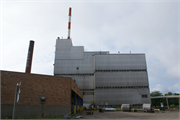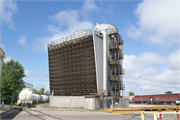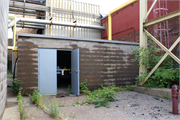Property Record
1535 2ND AVE S
Architecture and History Inventory
| Historic Name: | Port Edwards Mill |
|---|---|
| Other Name: | Nekoosa Papers Power Plant |
| Contributing: | |
| Reference Number: | 55895 |
| Location (Address): | 1535 2ND AVE S |
|---|---|
| County: | Wood |
| City: | Port Edwards |
| Township/Village: | |
| Unincorporated Community: | |
| Town: | |
| Range: | |
| Direction: | |
| Section: | |
| Quarter Section: | |
| Quarter/Quarter Section: |
| Year Built: | 1896 |
|---|---|
| Additions: | C. 1915C. 1920C. 1930C. 1940C. 1950C. 1960 |
| Survey Date: | 1978 |
| Historic Use: | power plant |
| Architectural Style: | Neoclassical/Beaux Arts |
| Structural System: | |
| Wall Material: | Brick |
| Architect: | |
| Other Buildings On Site: | |
| Demolished?: | No |
| Demolished Date: |
| National/State Register Listing Name: | Not listed |
|---|---|
| National Register Listing Date: | |
| State Register Listing Date: |
| Additional Information: | One of Wisconsin's largest paper companies, it was the first to adopt a program of reforestation. Resurveyed March 2014 under state statute 44.40 for Port Edwards Mill Demolition (FIN #50315), which proposes to demolish the southern half of the building and redevelop the northern portions which were built between the 1920s-1950s and post-1960. The history of Port Edwards is centered on the lumber and paper industries, which began as early as 1840, when John Edwards, Sr. and Henry Clinton erected the first sawmill in the village. John Edwards, Jr. and L.M. Alexander reorganized the mill under the name John Edwards Manufacturing Company in 1890, and continued to produce lumber, lath, shingles, and pickets. After the death of John Edwards, Jr., and with the lumber boom rapidly declining, L.M. Alexander demolished the saw mill and transitioned the company to manufacture paper. Construction of the new paper plant began in 1895. Within six years, the firm was operating two separate plants, at Port Edwards and Nekoosa. These, along with the Centralia Pulp and Power Company and several lumber businesses with large timber holdings, were consolidated into the Nekoosa-Edwards Paper Company (NEPCO) in 1908. This company became one of the leading paper producers in Wisconsin in the twentieth century, and was also significant for its pioneering role in reforestation. Organized in 1925, NEPCO’s Woodlands Department was the first industrial program for scientific forestry created in the Great Lakes region. After the Depression, the Nekoosa-Edwards Paper Company was among Wisconsin’s leading multi-national firms. The building is comprised of numerous astylistic utilitarian buildings constructed throughout the 20th century. Substantial additions to the north side of the building were constructed post-1960. |
|---|---|
| Bibliographic References: | Buehler, J. Marshall. Looking Back: A History of Port Edwards. Port Edwards, WI: Village of Port Edwards, 2002. Jones, George O. History of Wood County, Wisconsin. Minneapolis-Winona, MN: H.C. Cooper, Jr. & Co., 1923. University of Wisconsin, Historic Aerial Image Finder. “Wood County, 1938.” Accessed March 27, 2014. http://maps.sco.wisc.edu/WHAIFinder/# Wisconsin Historical Society. Sanborn Fire Insurance Map, 1902. Accessed March 27, 2014. http://content.wisconsinhistory.org/cdm/ref/collection/maps/id/5523 ________. Sanborn Fire Insurance Map, 1909. Accessed March 27, 2014. http://content.wisconsinhistory.org/cdm/ref/collection/maps/id/8660 Wyatt, Barbara L., editor. Cultural Resource Management in Wisconsin. 3 vols. Madison: State Historical Society of Wisconsin, 1986. |
| Wisconsin Architecture and History Inventory, State Historic Preservation Office, Wisconsin Historical Society, Madison, Wisconsin |





